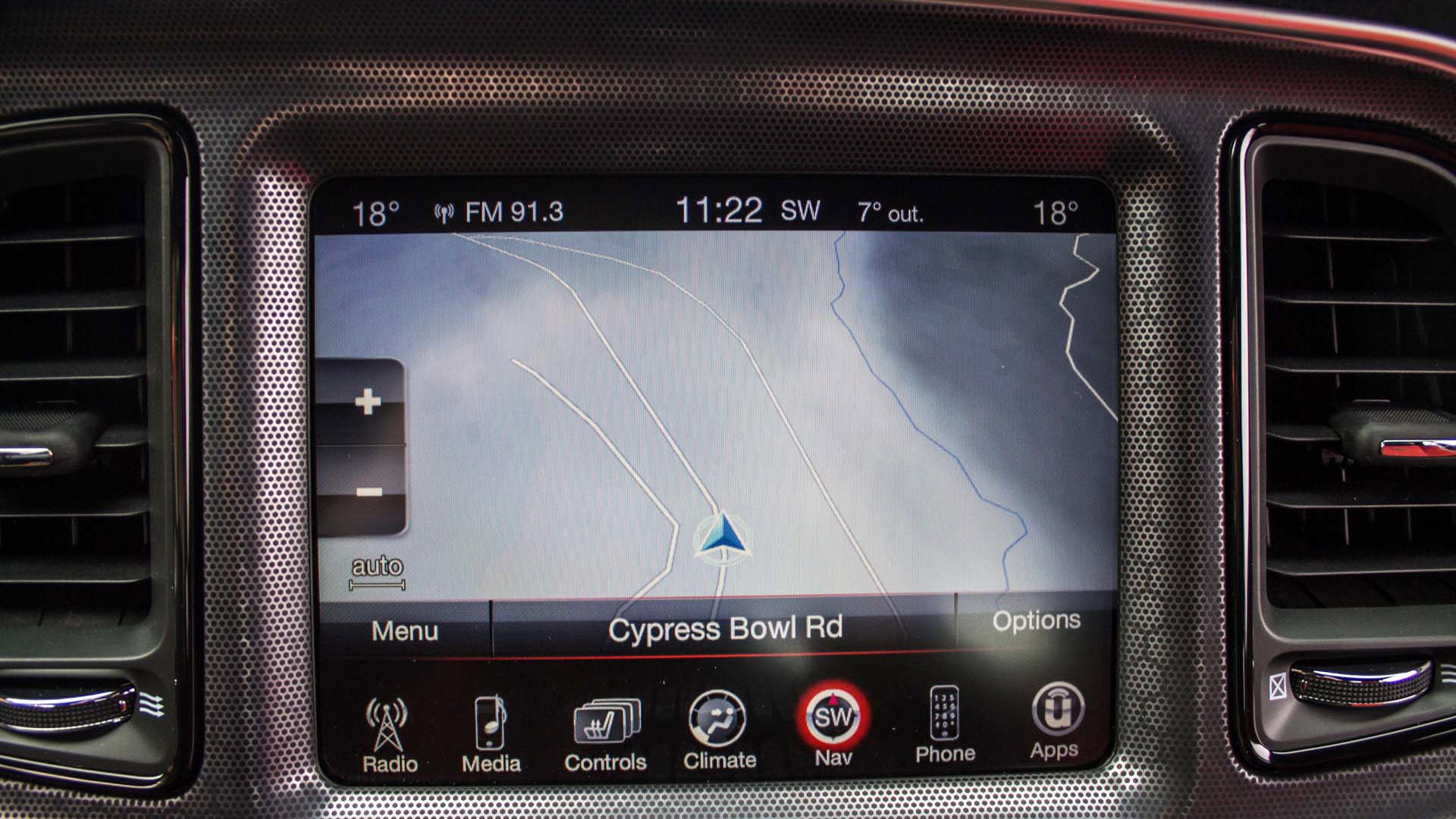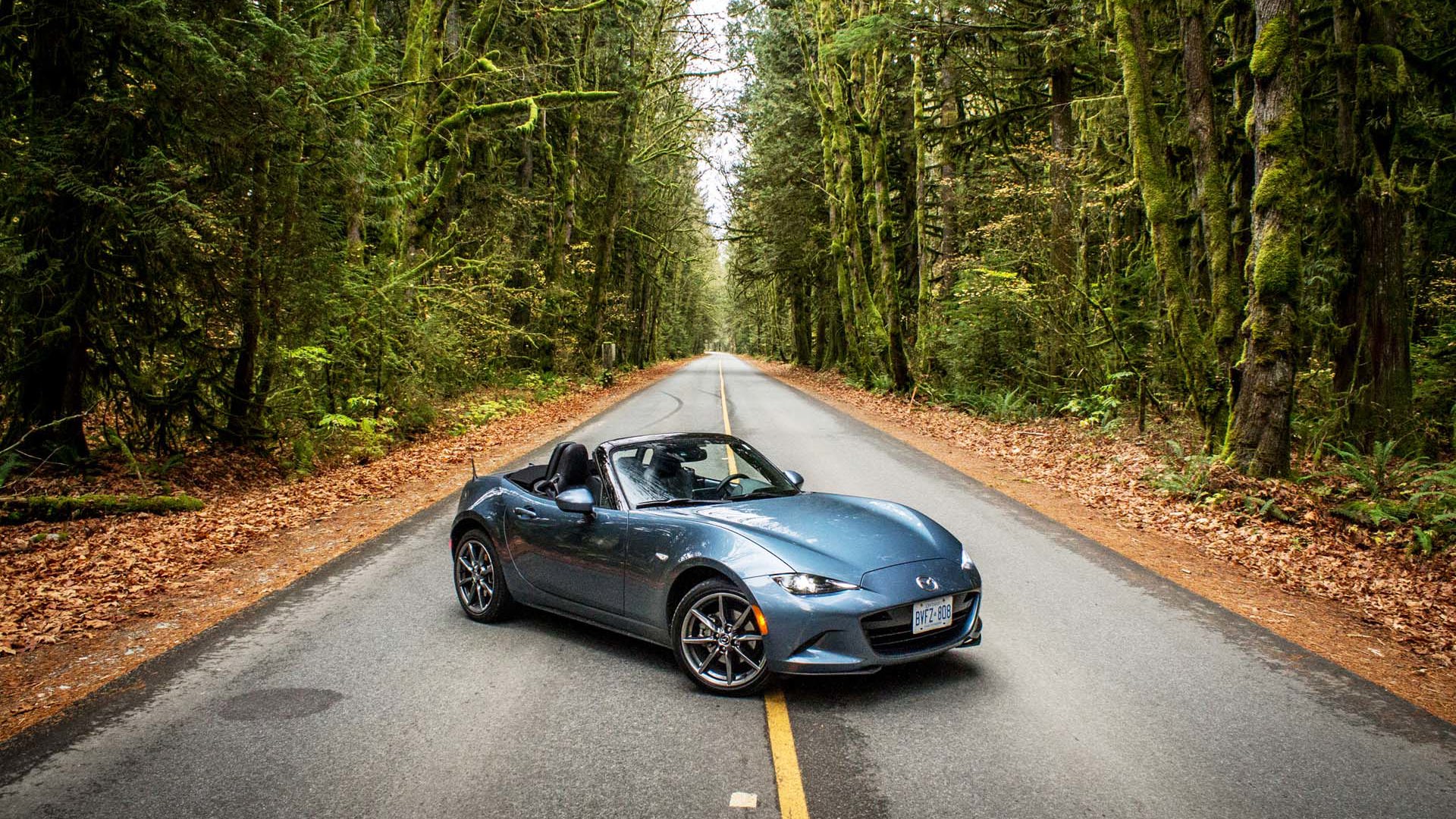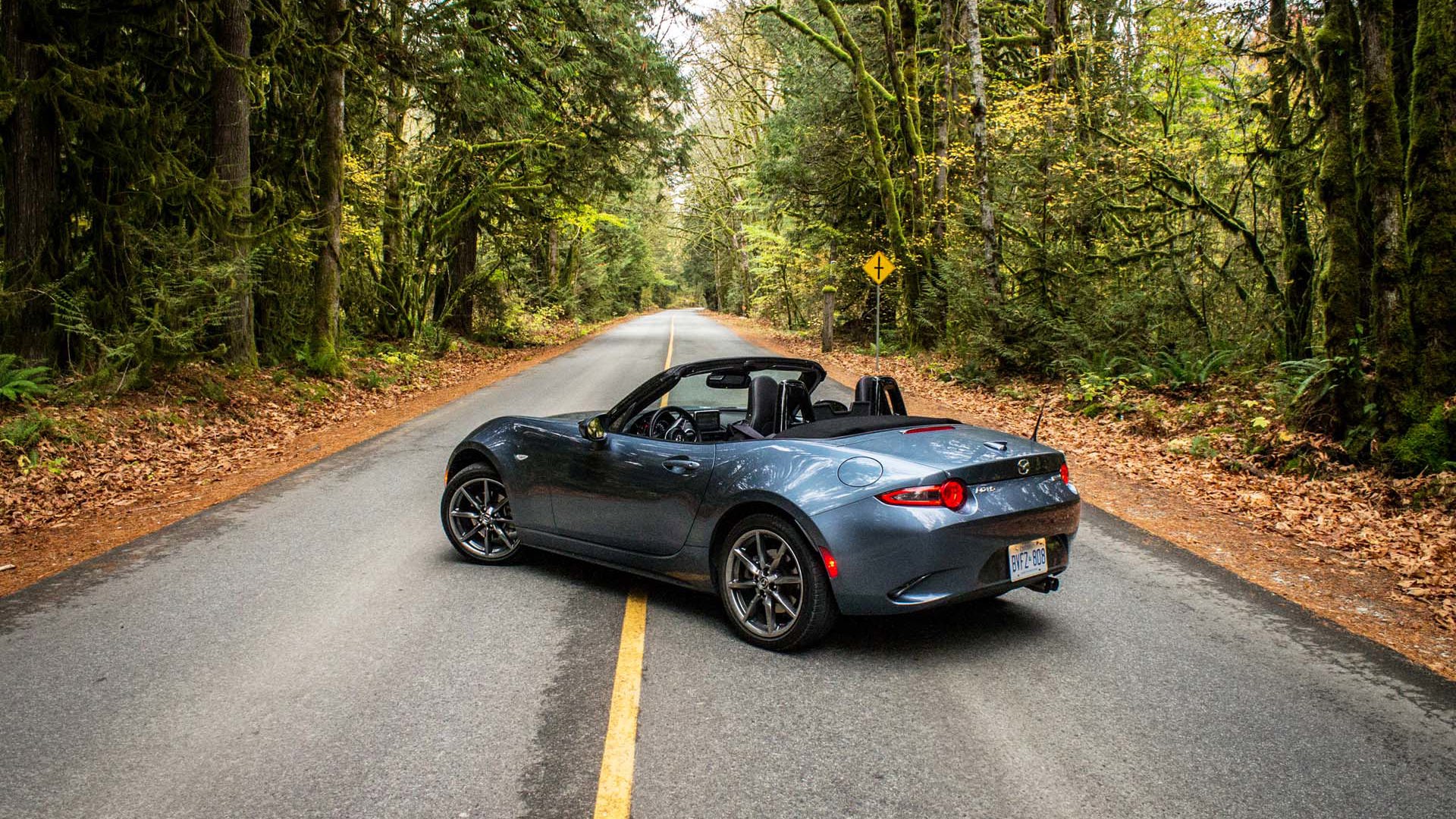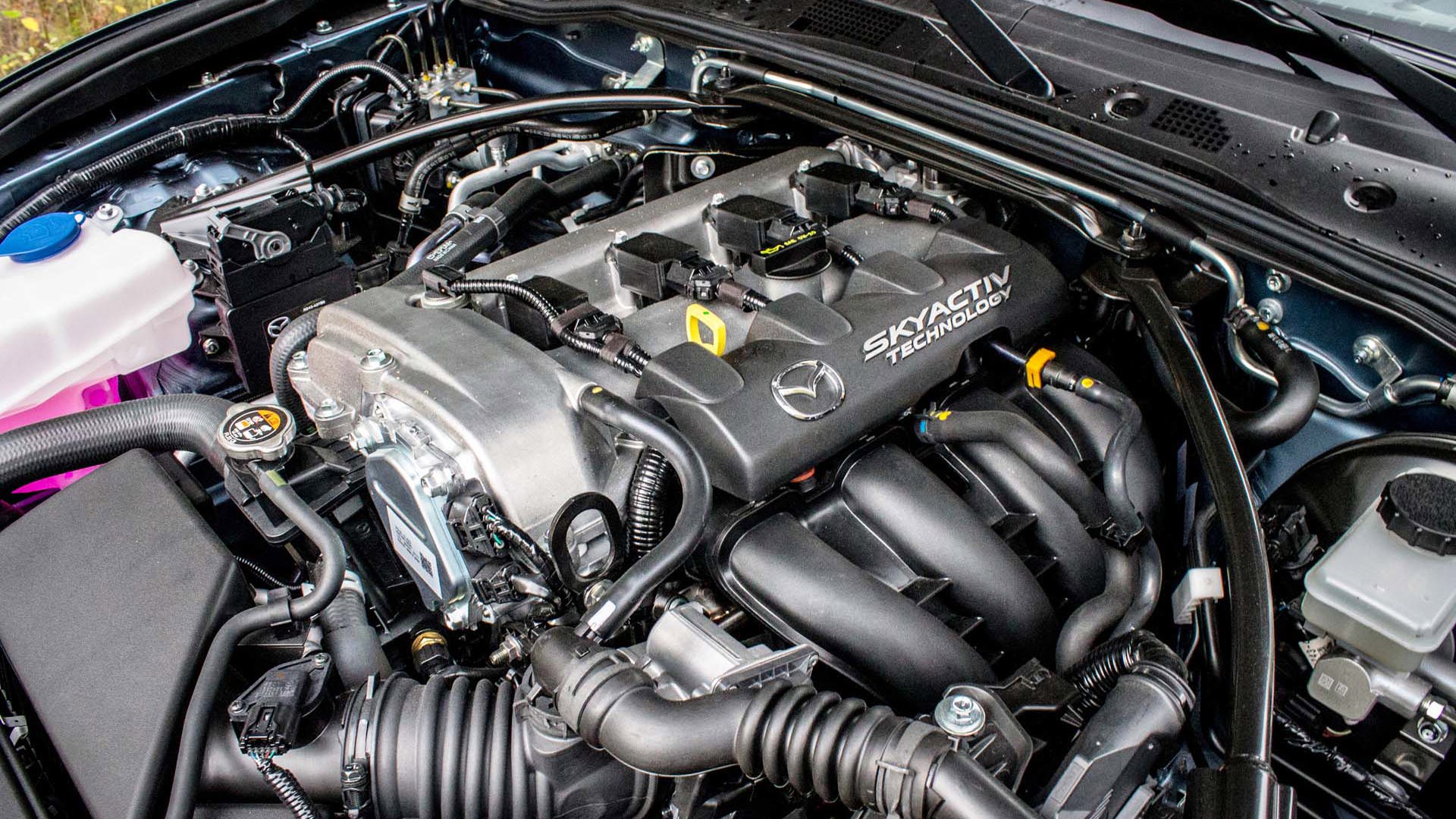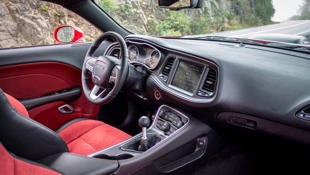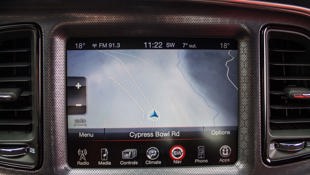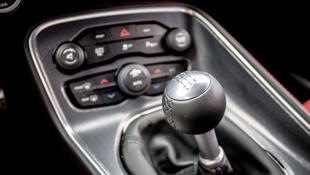Comparison Data
|
Base Price
$35,300
|
$46,995
|
|---|---|
|
Optional Equipment
None
|
$8735 (Preferred Package: Nappa leather, Shaker intake/hood, heated seats – $3000; rain-sending wipers, automatic headlights – $250; blind spot detection, universal garage door opener – $495; harman/kardon premium audio – $1500; Appearance package: spoiler, etc. – $695; 6-speed manual – $1000; Uconnect – $800)
|
|
A/C Tax
$100
|
$100
|
|
Destination Fee
$1795
|
$995
|
|
Price as Tested
$37,195
|
$56,530
|
Believe it or not, this isn't the dumbest thing we've ever done. No indeed – and it's not even close to being the silliest thing I've ever tackled (remember that time I road-tested a Hyundai Pony, for no discernible reason?).
One's a coupe, one's a convertible, but both these cars make a statement from the curb before they even move an inch.
Our forum watchdogs tend to tear into us whenever a B-segment crossover drifts into a C-segment shootout, so you can probably expect a few digitally rolled eyes at the comparison of these two machines, which nobody but Sméagol/Gollum would cross-shop. They have four wheels and two doors and internal combustion engines and there the similarity ends.
However, I feel like these two heroes have more in common than you might think. Each represents much of the essence of their parental brands, and each great fun in its own way: the MX-5, a barrel of spider-monkeys; the Challenger, a bucket of gorillas.
Head to head, it's an unfair fight that just might shed light on previously unseen strengths and weaknesses. David, grab your Skyactiv sling; Goliath, give your Hemi club a few experimental swings. Let's get this nonsense on.
Styling/Exterior
One's a coupe, one's a convertible, but both these cars make a statement from the curb before they even move an inch.
The Mazda: “Crouching Jaguar, hidden reliability.”
The Dodge: “Stay outta Riverdale!” *THUD*
In execution, the mighty-mite MX-5 looks even better in person than in photos. There are those who point out that it looks like Mazda cribbed the lines of the F-Type, but really, that's the best kind of flattery there is. Matter of fact, park the Jag next to the Japanese drophead and the former starts looking nearly ungainly, not unlike an early Ferrari California in the wrong colour.
Part of the reason I and many others find it hard to summon up any love for the Fiat-ized version of the MX-5 is that Mazda got nearly everything right the first time. The nose is low, the LED headlights slitted in a manga scowl, the goofy grin of the pre-facelift previous-gen gone in favour of a sort of modernized S2000. There's a lot to like here, even if the rear feels raised a little too high.
More unlikely pairs: Fraternal Twins: 10 Best Platform Sharing Models
If Fiat/Chrysler didn't quite get the styling right on their Sushi Bolognese Fiata, then they knocked retro-looks out of the park with a big slugger approach. Yes, the Challenger doesn't look quite as wide as the 1970s original thanks to a higher roofline, but apart from a straight-on view at the back end, this is a classically handsome machine. While the Camaro and the Mustang aim for a more modern overall feel, inside and out, the Dodge is just plain big. Those few little tweaks of the facelift (a more furrowed brow over the headlights) just add to the biggering. Throw in some retro decals and a totally superfluous “Shaker” hood, and you've got the automotive equivalent of firing off your shootin' irons into the air.
On one hand, a delicate fillet of tuna belly; on the other hand, a porterhouse the size of a hubcap. Both tasty.
Comfort/Interior
Obviously the square footage of the Mazda and the Dodge rates as apartment and ranch, respectively, but you can really boil down any interior comparison to an examination of the cupholders.
In the MX-5, the cupholders are these plug-in affairs that can either sit up by your elbow accomplishing nothing, or be fixed down on the right of the transmission tunnel, cramping your passenger's legs (if you have one). The best that can be said is that they're much better than Porsche's fussy afterthought of a robo-arm, poised to slop piping-hot Americano into the infotainment.
The Challenger gets two proper buckets, ready to accept the newest umpteen-litre-sized offering from Kwik-E-Mart. They ain't fancy, they're just part of the design rather than an afterthought – which says quite a bit about what this car was intended to do.
Aside from cups, you might need your machine to hold other things as well. The MX-5 does an okay job, with a trunk space that's got some decent depth to it, and could actually fit a few more items than the aforementioned F-Type. It's got a little more space in it for taller drivers thanks to the inclined rail of the sliding seat, but there's little in-cabin storage space.
The Dodge, as you'd expect, has much more room, and the 2+2 configuration means you can fit a rear seat back there. This is important, because kids absolutely love the crap out of this thing. It's basically Clifford the Big Red Dodge, a lovable lout with a stout-hearted rumble. Getting my daughter's car seat wedged into the back was a bit of a challenge, but once she was in there, there was an ever-present squeal to “go faster!”
Now, to the unexpected: the seats in the Challenger were far more aggressively side-bolstered than the MX-5's. Both were comfy, and a tip of the hat to Mazda's engineers for figuring out how to drop the hip point until you're nearly bouncing your butt off the cat's-eyes, but the Dodge's thrones were clearly more sport-oriented. This makes no sense, surely? I thought Yank-tanks couldn't corner?
(NB: the Canadian MX-5 equivalent of the US Club version is coming to market next year with a set of uprated Recaros for those who need more lateral stability to go with their top-down shenanigans.)
Technology
Up to this point, we've taken a few shots at the theoretical IQ of the Challenger. However, in terms of onboard tech, Moose Mason has brushed up on his SAT scores. When optioned with the 8.4-inch Uconnect system, the Challenger picks up the same ease-of-use that you get in a nicely equipped Grand Cherokee or similar. Yes, there is the slight sense that an eight-track with a copy of Foghat's Slow Ride might be more appropriate, but modern owners will appreciate being able to Bluetooth-stream the band's entire catalog.
The MX-5 gets Mazda's infotainment system, which is also straightforward to use, but isn’t quite as well integrated. The handy pocket for your smartphone to plug into a USB port is clever, though.
Bluetooth is standard on both the Mazda and the Dodge, but here's where the two companies start to differ in their approach. Want an MX-5? Choose one of three trims and pick your colour. Job done. Want a Challenger? There's a lot more choice and customization involved, but that means there's also plenty of options to run up the total bill. Base price on my tester R/T started at $46,995 and ballooned by nearly ten grand above that. Per pound, the Dodge still looks like a good deal, but you've got to watch for price bloat.
Performance
On to the red meat, both the thinly shaved and the well-marbled varieties. Conventional internet wisdom says one of these cars can't accelerate and the other can't handle. Everybody's sort of wrong.
With a peak 155-hp rating, the MX-5's new 2.0L four-cylinder engine gives up twelve horsepower to the outgoing car's MZR 2.0L. This, to paraphrase Douglas Adams, has made a lot of people very angry and been widely regarded as a bad idea. Cars don't get less powerful as time goes on, they get more powerful. It's an outrage. A travesty. Somehow, that Obama fellow's probably responsible.
Thing is, the new MX-5 still manages to pull off some pretty solid performance figures. In instrumented testing by Car and Driver, the MX-5 ripped off a sub-6-second sprint to 100 km/h en route to posting a quarter-mile time in the mid-14 second range. When C&D tested the 200-hp Scion FR-S, they came up with figures nearly a second slower. If you're a Miata fan reading this, note that the new car easily puts the boots to the stock turbocharged Mazdaspeed Miata, too.
Let's be serious, the MX-5 is going to have trouble keeping ahead of a V6 Camry at the drag strip, so it's no straight-line hero. However, it's not just an overactive butt-dyno and the rushing air of top-down motoring: this little car is plenty quick enough to be lively.
And as for our crimson lead-sled, theoretically incapable of handling a curve? Well, while the experience of driving the Challenger is a bit like a stage-coach attached to an entire ranch of horseflesh stampeding after a carrot, it's actually much better behaved than you might think. The long wheelbase of the car means that quick transitions aren't a strong point, but overall cornering grip through tight, sweeping curves means you actually need those side bolsters.
To steal a few more figures from C&D, an automatic-equipped Scat Pack Challenger pulled the same 0.9 g that the Miata does when the latter is equipped with the BBS wheels and stickier tires. Big Red may be a Labrador at heart, but he doesn't roll over like one.
And as for straight-line performance, holy scat! The R/T Chally has plenty of mass to dispose of, but that gargantuan 6.8L V8 turfs out 485 hp and 475 lb-ft of torque, easily capable of crushing out quarter-mile times in the 12-second range. To say there's a lot of theatre involved in knocking out acceleration runs is a bit of an understatement: the Challenger is all 'bout lifting the nose and wobbling the shaker hood blister, roaring and shouting and growling and snarling. It's utterly hilarious, and with a long wheelbase taming a swinging rear end naturally, you will want to smoke them early and often.
Both cars could not be more opposite in feel. The Dodge is heavy, with a shifter like a railroad switch and tendency to lunge. The MX-5 is delicate and frenetic, and loves it best if flogged to within a micrometre of tire adhesion. Both are a single traction-button press away from nirvana. Both are totally lovable. You could make a case for either one.
Livability
While it could be argued that either one of these machines works best as a third car, the Challenger ain't a Hellcat, and the Miata's not some emissions-belching FD-chassis RX-7. You could quite easily drive these cars every day of the year if you put the right tires on when the temperatures drop.
While the Dodge is a much more comfortable cruiser, and would make an excellent road-trip companion for crossing the desert states en route to the Grand Canyon, the Miata's probably the easier machine to live with every day if you don't need extra seats. The top goes down so fast, you'll be able to eke out every moment of convertible driving, every rare ray of winter sun there is. The power's so modest, weather hardly matters.
And then there's the fuel economy, which is hugely improved over the old car (premium still required), and certainly a lot better than the Challenger's big V8. For the latter, the eight-speed automatic will probably tame the beast somewhat, especially on the highway.
Conclusion
Here's the entirely subjective part, and the one that's surprisingly trickier to work out. The theoretical blunt instrument here is actually subtler than you'd think, and a lot more fun. It's no one-trick muscle car, but at least competent enough through corners to make you grin. You find excuses to take it out and go driving, and I can't think of a better compliment to a car than that.
The MX-5, on the other hand, was always going to be tough to beat. David always beats Goliath in the end. Poor Goliath. I wonder if there's a support group for all the Goliaths out there.
The thing about the MX-5 is that I could pick any of the roads I drove this year, from Spain to California to hidden old routes around BC, and I'd have more fun in the MX-5 than almost anything else I've driven. Everyone who fits in the car raves about it, and they should. You can put it up against anything short of a pickup truck, and it'll come out a winner.
| 2016 Mazda MX-5 Warranty 3 years/unlimited distance; 5 years/unlimited distance powertrain; 7 years/unlimited distance corrosion perforation; 3 years/unlimited distance roadside assistance |
| 2015 Dodge Challenger R/T Scat Pack Warranty 3 years/60,000 km; 5 years/100,000 km powertrain; 3 years/unlimited distance corrosion perforation; 5 years/100,000 km roadside assistance |


















